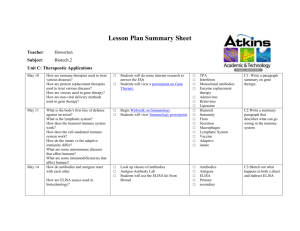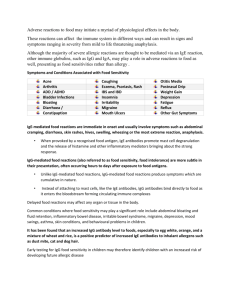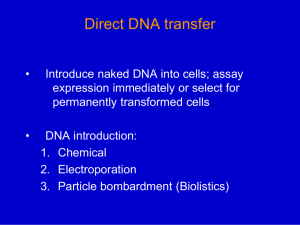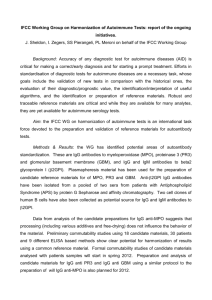Chapter 20
advertisement
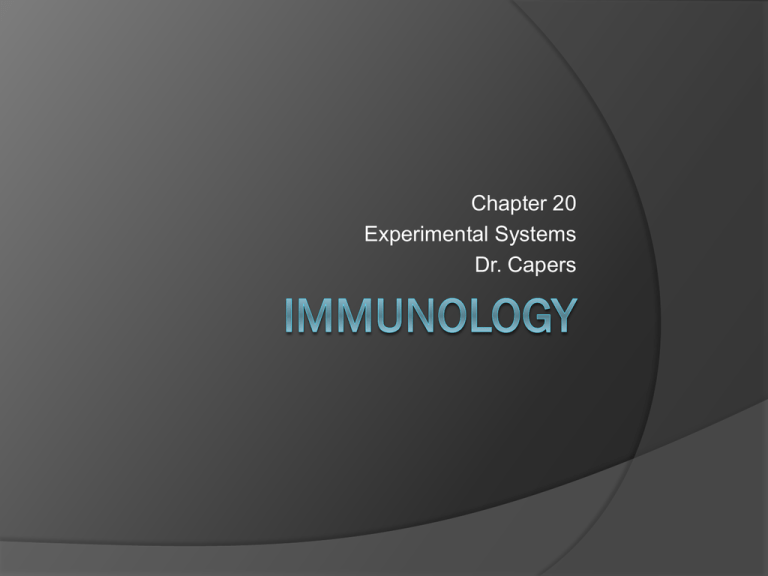
Chapter 20 Experimental Systems Dr. Capers In vivo ○ Involve whole animal In vitro ○ Defined populations of immune cells are studied under controlled lab conditions Study of immune system requires suitable animal models ○ For vaccine development – is the animal model susceptible to the disease? ○ Mouse most often used ○ Inbred strains reduce variation caused by differences in genetic backgrounds - 20 or more generations of brother-sister mating ○ Have to abide by IACUC guidelines Adoptive Transfer ○ Immune system of model animal can be eliminated ○ Replaced with immune cells of animal to be studied Use of polyclonal antibodies ○ Immunizing animal (mouse, rabbit) or human with antigen one or more times ○ Taking blood samples, purifying the antibodies from the serum ○ Results in a mixture of antibodies directed towards variety of different epitopes ○ Disadvantages: - Ill-defined cross-reactivities with related antigens - Range of cross-reactivity to desired antigen might vary from bleed to bleed - Animal might die, causing you to start over Use of monoclonal antibodies ○ Product of single, stimulated B cell - Supply of antibody specific for one epitope ○ Uses: - Can be specific for specific targe cells and conjugated to toxins - More sensitive/specific ELISAs Cell Culture Systems ○ Cells are cultured and studied ○ Specialized media ○ Can be used for: - Testing effects of contaminants on immune cells - Testing drugs - Producing monoclonal antibodies ○ Cell line Cells that have been transformed – propagate indefinitely (cancerous cells) Fusion producing hybridoma Protein Biochemistry Biotin labels ○ Biotin – small molecule that can be bound to antibody ○ Used in ELISA ○ Reacts with avidin to produce color change Let’s say I’m trying to develop an ELISA to detect HS (harbor seal) IgG antibody levels in serum ○ Need a monoclonal antibody specific for HS IgG ○ So, I isolate HS IgG using column chromatography, inject mouse, mouse produces anti-IgG (remember there are idiotypic differences between IgG of mouse and another species) ○ Extract spleen (there are some B cells producing antibodies specific to the HS IgG I innoculated with); perform fusion to create hybridomas ○ After a few weeks, I have some living hybridomas – perform ELISA to see if they are producing antibody ○ Isolate the hybridomas (want to make sure I only have clones from 1 B cell) ○ My ELISA tells me they are producing anti-HS IgG but I want to see if the epitope is on the light or heavy chain - Coat plate with isolated HS IgG, then add media from monoclonals containing anti-HS IgG, followed by biotinylated anti-mouse ○ Therefore, I can use a Western blot to see this - Next 2 slides Protein Biochemistry Gel Electrophoresis ○ SDS-PAGE SDS is a detergent, binds to proteins and destroys tertiary and secondary structure Proteins can be separated according to molecular weight - Separation of antibody classes (different heavy chains, separation of light and heavy chains) - Run IgG I’m interested in looking at (HS-IgG I injected into mouse) - This can then be used in Western Blot (next slide) Protein Biochemistry X-ray crystallography ○ Limit of light microscopy is resolution ○ X-rays are transmitted through crystallized protein Different atoms will scatter the x-rays differently Pattern contains information of position of atoms within the molecule Detector records pattern of spots Mathematical deduction leads to calculation of structure Recombinant DNA Technology Restriction enzymes cleave DNA at precise sequences DNA sequences are cloned into vectors ○ Virus If it’s a bacteriophage, it can then infect bacteria and the bacteria will express inserted gene ○ Plasmid Gene of interest is inserted into plasmid containing antibiotic resistance gene, incubated with bacterial cells, if bacteria uptake plasmid they will be able to grow on medium with antibiotic Recombinant DNA Technology Cloning of cDNA and genomic DNA ○ Messenger RNA isolated from cells can be transcribed into complementary DNA ○ This can be inserted into vector and then expressed ○ cDNA library Expressed genes of cell Recombinant DNA Technology Southern Blotting Recombinant DNA Technology ○ Small amounts of DNA that are used for testing can be amplified by PCR Gene Transfer Common technique ○ Retrovirus – replace viral structural gene with clone gene to be transfected ○ Virus is now used as vector to insert new gene into cultured cells ○ Inserting these transgenes into mouse embryos allows researchers to study effects of immune system genes in vivo Gene Transfer Knockout mice ○ Replace normal gene with mutant allele Microarrays Assess differences in gene expression between cell types Can scan large #’s of mRNAs Procedure ○ mRNA isolated, cDNA synthesis is initiated ○ First strand of cDNA is labeled with tag ○ Labeled cDNA is then hybridized with nucleic acid affixed in microarray Fluorescent Technology Green fluorescent protein ○ Isolated from bioluminescent jellyfish, naturally occurring ○ Can be used to visualize live cells
